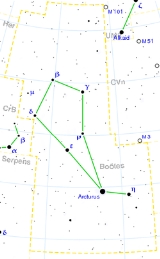
Xi Boötis
Encyclopedia
Xi Boötis is a binary star
system 22 light years away from Earth
. It is the nearest visible star in the constellation Boötes
.
The primary star in this system, ξ Boötis A, is a BY Draconis variable
with an apparent magnitude
that varies from +4.52 to +4.67 with a period just over 10 days long, and is classified as a yellow G-type
main sequence dwarf
. Small velocity changes in the orbit of the companion star, ξ Boötis B, an orange K-type main sequence dwarf
, indicate the presence of a small companion that is less than nine times the mass of Jupiter
. The AB binary can be resolved even through smaller telescopes. The binary system contains some of the closest young solar-type stars to the Sun, with a system age of about 200 million years old.
The primary star (A) has been identified as a candidate for possessing a Kuiper-like belt
, based on infrared
observations. The estimated minimum mass of this dust disk is 2.4 times the mass of the Earth's Moon
. (Compare to the value of 8.2 lunar masses for the Kuiper belt.)
Binary star
A binary star is a star system consisting of two stars orbiting around their common center of mass. The brighter star is called the primary and the other is its companion star, comes, or secondary...
system 22 light years away from Earth
Earth
Earth is the third planet from the Sun, and the densest and fifth-largest of the eight planets in the Solar System. It is also the largest of the Solar System's four terrestrial planets...
. It is the nearest visible star in the constellation Boötes
Boötes
Boötes is a constellation in the northern sky, located between 0° and +60° declination, and 13 and 16 hours of right ascension on the celestial sphere. The name comes from the Greek Βοώτης, Boōtēs, meaning herdsman or plowman...
.
The primary star in this system, ξ Boötis A, is a BY Draconis variable
BY Draconis variable
BY Draconis variables are main sequence variable stars of late spectral types, usually K or M. The name comes from the archetype for this category of variable star system, BY Draconis. They exhibit variations in their luminosity due to rotation of the star coupled with star spots, and other...
with an apparent magnitude
Apparent magnitude
The apparent magnitude of a celestial body is a measure of its brightness as seen by an observer on Earth, adjusted to the value it would have in the absence of the atmosphere...
that varies from +4.52 to +4.67 with a period just over 10 days long, and is classified as a yellow G-type
Stellar classification
In astronomy, stellar classification is a classification of stars based on their spectral characteristics. The spectral class of a star is a designated class of a star describing the ionization of its chromosphere, what atomic excitations are most prominent in the light, giving an objective measure...
main sequence dwarf
Main sequence
The main sequence is a continuous and distinctive band of stars that appears on plots of stellar color versus brightness. These color-magnitude plots are known as Hertzsprung–Russell diagrams after their co-developers, Ejnar Hertzsprung and Henry Norris Russell...
. Small velocity changes in the orbit of the companion star, ξ Boötis B, an orange K-type main sequence dwarf
Main sequence
The main sequence is a continuous and distinctive band of stars that appears on plots of stellar color versus brightness. These color-magnitude plots are known as Hertzsprung–Russell diagrams after their co-developers, Ejnar Hertzsprung and Henry Norris Russell...
, indicate the presence of a small companion that is less than nine times the mass of Jupiter
Jupiter
Jupiter is the fifth planet from the Sun and the largest planet within the Solar System. It is a gas giant with mass one-thousandth that of the Sun but is two and a half times the mass of all the other planets in our Solar System combined. Jupiter is classified as a gas giant along with Saturn,...
. The AB binary can be resolved even through smaller telescopes. The binary system contains some of the closest young solar-type stars to the Sun, with a system age of about 200 million years old.
The primary star (A) has been identified as a candidate for possessing a Kuiper-like belt
Kuiper belt
The Kuiper belt , sometimes called the Edgeworth–Kuiper belt, is a region of the Solar System beyond the planets extending from the orbit of Neptune to approximately 50 AU from the Sun. It is similar to the asteroid belt, although it is far larger—20 times as wide and 20 to 200 times as massive...
, based on infrared
Infrared
Infrared light is electromagnetic radiation with a wavelength longer than that of visible light, measured from the nominal edge of visible red light at 0.74 micrometres , and extending conventionally to 300 µm...
observations. The estimated minimum mass of this dust disk is 2.4 times the mass of the Earth's Moon
Moon
The Moon is Earth's only known natural satellite,There are a number of near-Earth asteroids including 3753 Cruithne that are co-orbital with Earth: their orbits bring them close to Earth for periods of time but then alter in the long term . These are quasi-satellites and not true moons. For more...
. (Compare to the value of 8.2 lunar masses for the Kuiper belt.)

